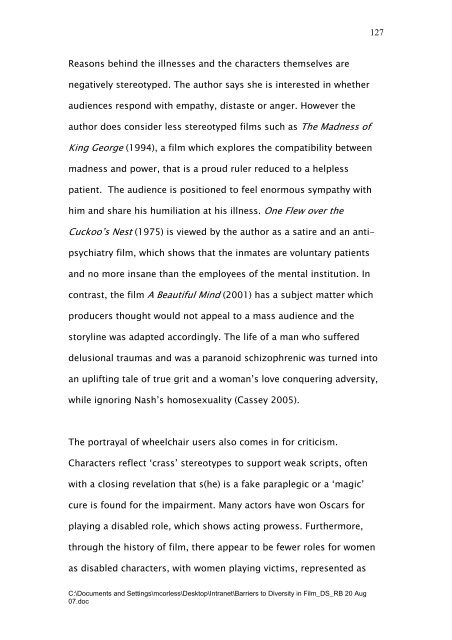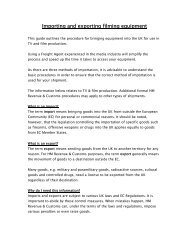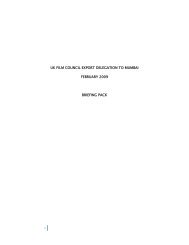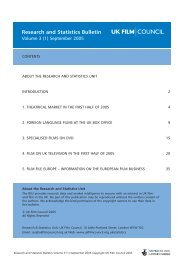Barriers to Diversity in Film – A Research Review – Aug 07
Barriers to Diversity in Film – A Research Review – Aug 07
Barriers to Diversity in Film – A Research Review – Aug 07
Create successful ePaper yourself
Turn your PDF publications into a flip-book with our unique Google optimized e-Paper software.
Reasons beh<strong>in</strong>d the illnesses and the characters themselves are<br />
negatively stereotyped. The author says she is <strong>in</strong>terested <strong>in</strong> whether<br />
audiences respond with empathy, distaste or anger. However the<br />
author does consider less stereotyped films such as The Madness of<br />
K<strong>in</strong>g George (1994), a film which explores the compatibility between<br />
madness and power, that is a proud ruler reduced <strong>to</strong> a helpless<br />
patient. The audience is positioned <strong>to</strong> feel enormous sympathy with<br />
him and share his humiliation at his illness. One Flew over the<br />
Cuckoo’s Nest (1975) is viewed by the author as a satire and an anti-<br />
psychiatry film, which shows that the <strong>in</strong>mates are voluntary patients<br />
and no more <strong>in</strong>sane than the employees of the mental <strong>in</strong>stitution. In<br />
contrast, the film A Beautiful M<strong>in</strong>d (2001) has a subject matter which<br />
producers thought would not appeal <strong>to</strong> a mass audience and the<br />
s<strong>to</strong>ryl<strong>in</strong>e was adapted accord<strong>in</strong>gly. The life of a man who suffered<br />
delusional traumas and was a paranoid schizophrenic was turned <strong>in</strong><strong>to</strong><br />
an uplift<strong>in</strong>g tale of true grit and a woman’s love conquer<strong>in</strong>g adversity,<br />
while ignor<strong>in</strong>g Nash’s homosexuality (Cassey 2005).<br />
The portrayal of wheelchair users also comes <strong>in</strong> for criticism.<br />
Characters reflect ‘crass’ stereotypes <strong>to</strong> support weak scripts, often<br />
with a clos<strong>in</strong>g revelation that s(he) is a fake paraplegic or a ‘magic’<br />
cure is found for the impairment. Many ac<strong>to</strong>rs have won Oscars for<br />
play<strong>in</strong>g a disabled role, which shows act<strong>in</strong>g prowess. Furthermore,<br />
through the his<strong>to</strong>ry of film, there appear <strong>to</strong> be fewer roles for women<br />
as disabled characters, with women play<strong>in</strong>g victims, represented as<br />
C:\Documents and Sett<strong>in</strong>gs\mcorless\Desk<strong>to</strong>p\Intranet\<strong>Barriers</strong> <strong>to</strong> <strong>Diversity</strong> <strong>in</strong> <strong>Film</strong>_DS_RB 20 <strong>Aug</strong><br />
<strong>07</strong>.doc<br />
127
















